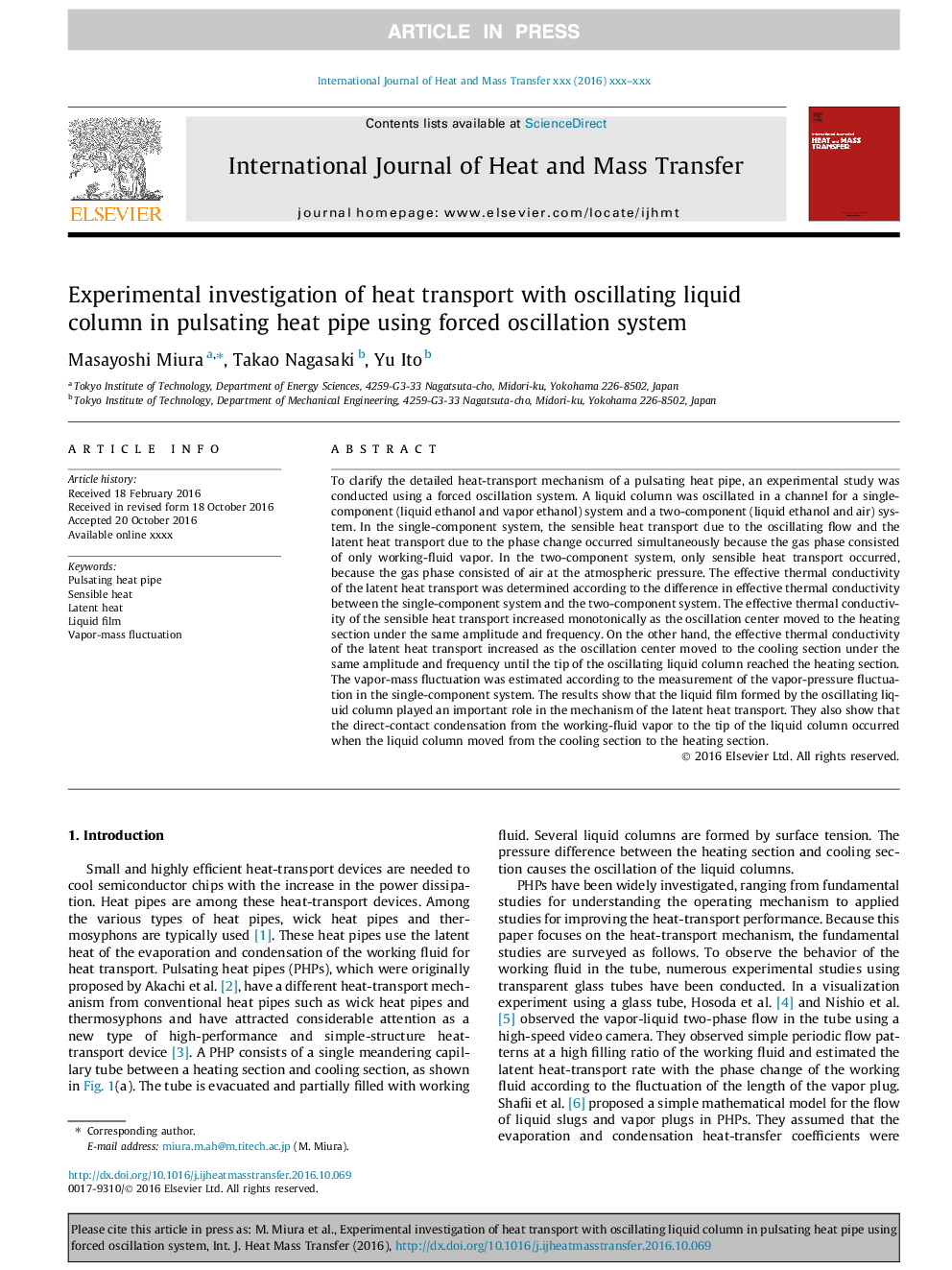| کد مقاله | کد نشریه | سال انتشار | مقاله انگلیسی | نسخه تمام متن |
|---|---|---|---|---|
| 4994826 | 1458036 | 2017 | 8 صفحه PDF | دانلود رایگان |
عنوان انگلیسی مقاله ISI
Experimental investigation of heat transport with oscillating liquid column in pulsating heat pipe using forced oscillation system
ترجمه فارسی عنوان
بررسی تجربی حمل و نقل گرما با ستون مایع ارتعاشی در لوله های گرمای تابشی با استفاده از سیستم نوسان مجاز
دانلود مقاله + سفارش ترجمه
دانلود مقاله ISI انگلیسی
رایگان برای ایرانیان
کلمات کلیدی
لوله پالسی گرم حرارت معقول، حرارت نهان، فیلم مایع، نوسانات جرمی بخار،
ترجمه چکیده
برای روشن ساختن مکانیزم دقیق ترانسفورماتور حرارتی یک لوله گرمای خازنی، یک مطالعه تجربی با استفاده از یک سیستم نوسان مجاز انجام شد. ستون مایع در یک کانال برای یک سیستم (مایع اتانول و بخار اتانول) و یک سیستم دو جزء (مایع اتانول و هوا) نوسان کرد. در سیستم تک مولفه، انتقال حرارت معقول به دلیل جریان نوسان و انتقال حرارتی پنهان به علت تغییر فاز رخ داده است به طور همزمان، زیرا فاز گاز فقط شامل بخار مایع کار می کند. در سیستم دو جزء، تنها انتقال حرارت معقول رخ داده است، زیرا فاز گاز شامل هوا در فشار اتمسفر است. هدایت حرارتی مؤثر انتقال حرارت پنهان با توجه به تفاوت هدایت حرارتی مؤثر بین سیستم تک مولفه و سیستم دو جزء تعیین شد. هدایت حرارتی مؤثر انتقال گرما حساس به طور یکنواخت افزایش یافته است به عنوان مرکز نوسان حرکت به بخش گرما تحت همان دامنه و فرکانس. از سوی دیگر، هدایت حرارتی مؤثر انتقال حرارت پنهان به دلیل اینکه مرکز نوسان به همان بخش دامنه و فرکانس حرکت می کند تا بخش خنک کننده مایع به بخش بخار تبدیل می شود، افزایش می یابد. نوسانات جرمی بخار بر اساس اندازه گیری نوسانات فشار بخار در سیستم تک تک محاسباتی محاسبه شد. نتایج نشان می دهد که فیلم مایع تشکیل شده توسط ستون مایع نوسان نقش مهمی در مکانیزم انتقال حرارت پنهان دارد. همچنین نشان می دهد که تراکم مستقیم تماس از بخار مایع کار به نوک ستون مایع هنگامی رخ داد که ستون مایع از بخش خنک کننده به قسمت گرما منتقل شد.
موضوعات مرتبط
مهندسی و علوم پایه
مهندسی شیمی
جریان سیال و فرایندهای انتقال
چکیده انگلیسی
To clarify the detailed heat-transport mechanism of a pulsating heat pipe, an experimental study was conducted using a forced oscillation system. A liquid column was oscillated in a channel for a single-component (liquid ethanol and vapor ethanol) system and a two-component (liquid ethanol and air) system. In the single-component system, the sensible heat transport due to the oscillating flow and the latent heat transport due to the phase change occurred simultaneously because the gas phase consisted of only working-fluid vapor. In the two-component system, only sensible heat transport occurred, because the gas phase consisted of air at the atmospheric pressure. The effective thermal conductivity of the latent heat transport was determined according to the difference in effective thermal conductivity between the single-component system and the two-component system. The effective thermal conductivity of the sensible heat transport increased monotonically as the oscillation center moved to the heating section under the same amplitude and frequency. On the other hand, the effective thermal conductivity of the latent heat transport increased as the oscillation center moved to the cooling section under the same amplitude and frequency until the tip of the oscillating liquid column reached the heating section. The vapor-mass fluctuation was estimated according to the measurement of the vapor-pressure fluctuation in the single-component system. The results show that the liquid film formed by the oscillating liquid column played an important role in the mechanism of the latent heat transport. They also show that the direct-contact condensation from the working-fluid vapor to the tip of the liquid column occurred when the liquid column moved from the cooling section to the heating section.
ناشر
Database: Elsevier - ScienceDirect (ساینس دایرکت)
Journal: International Journal of Heat and Mass Transfer - Volume 106, March 2017, Pages 997-1004
Journal: International Journal of Heat and Mass Transfer - Volume 106, March 2017, Pages 997-1004
نویسندگان
Masayoshi Miura, Takao Nagasaki, Yu Ito,
